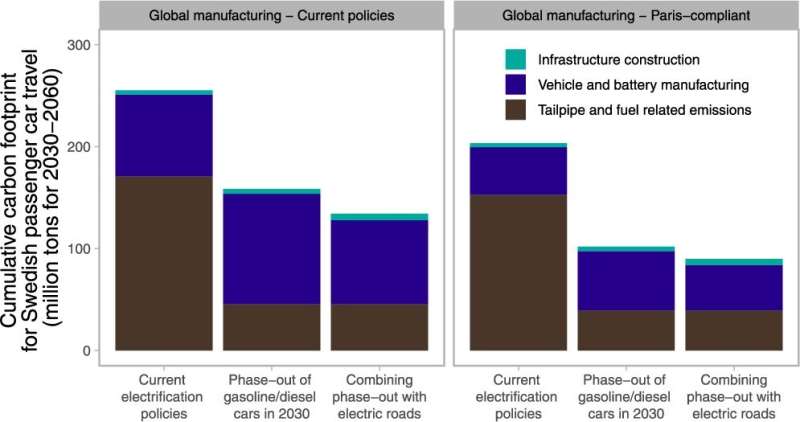
If an electric car charges while driving, the size of the battery can be reduced by up to 70 percent, and the load on the power grid can be spread out over the day. Charging on the move suits most people, but not everyone. This is shown by a new study from Chalmers University of Technology, Sweden, where for the first time researchers combine the so-called electric road system with real-life driving patterns of Swedish drivers.
The Swedish government has proposed a ban on new petrol and diesel cars from 2030 to reduce carbon dioxide emissions. The same trends are seen across Europe, as demonstrated by the rapid increasing sales of electric vehicles. As this development progresses, challenges are also increasing, including the uneven load on the power grid and where to charge the electric vehicles.
Different ways of charging vehicles on the move
Several countries, including Sweden, Denmark, and Germany, are testing whether electric road system (ERS) can be used to electrify road networks. An ERS charges moving vehicles with either loops in or next to the road, or with wires suspended above vehicles, similar to trams and trains.
All variants mean that vehicles do not need to be parked to charge, and there are less needs for large batteries storing energy to overcome “range anxiety,” a term referring to the fear or concern of an electric vehicle driver’s experiences about the distance their electric vehicle can travel before the battery needs to be charged.
Now researchers from Chalmers have used data from over 400 passenger cars to study real driving patterns on different parts of Swedish national and European roads. They have used the data to calculate, among other things, battery size needs to complete all journeys given possible charging options (stationary versus ERS), charging patterns, and total costs including infrastructure and batteries.
Smaller battery results in lower costs
The results show that a combination of electric roads on 25 percent of the busiest national and European roads and home charging would be optimal. The batteries, which account for a large part of the cost for an electric car, can become significantly smaller, at best only one-third of the current size.
“We see that it is possible to reduce the required range of batteries by more than two thirds if you combine charging in this way. This would reduce the need for raw materials for batteries, and an electric car could also become cheaper for the consumer,” says Sten Karlsson, who, together with research colleagues Wasim Shoman and Sonia Yeh, is behind the study “Benefits of an Electric Road System for Battery Electric Vehicles.”
Other positive effects are that peaks in electricity consumption would be reduced if car drivers did not entirely rely on home charging but also supplemented it with electric road charging.
“After all, many people charge their cars after work and during the night, which puts a lot of strain on the power grid. By instead charging more evenly throughout the day, peak load would be significantly reduced.”
Limited benefit in sparsely populated areas
But different groups of motorists also have different conditions for benefiting from the combination of stationary charging and ERS.
“There are big differences between groups, depending on driving patterns and proximity to electric roads. Even in the optimal case, some would manage with only electric road charging, while others would not be able to use the opportunity at all. For example, we see that those who live in the countryside would need almost 20 percent greater range on their batteries compared to those who live in a city center,” says Wasim Shoman.
The study also shows that small batteries do not automatically lead to charging through ERS.
“Just because you can charge does not mean the consumer actually wants to do it at every given opportunity. The business model, therefore, becomes extremely important because benefits and costs may become unevenly distributed. And there are no decisions yet on what the business model should look like,” says Sten Karlsson.
The study is published in the journal Environmental Science & Technology.
More information:
Johannes Morfeldt et al, If Electric Cars Are Good for Reducing Emissions, They Could Be Even Better with Electric Roads, Environmental Science & Technology (2022). DOI: 10.1021/acs.est.2c00018
Citation:
Electric roads would pave the way for smaller car batteries, shows modeling study (2023, March 28)
retrieved 28 March 2023
from https://techxplore.com/news/2023-03-electric-roads-pave-smaller-car.html
This document is subject to copyright. Apart from any fair dealing for the purpose of private study or research, no
part may be reproduced without the written permission. The content is provided for information purposes only.
Stay connected with us on social media platform for instant update click here to join our Twitter, & Facebook
We are now on Telegram. Click here to join our channel (@TechiUpdate) and stay updated with the latest Technology headlines.
For all the latest Technology News Click Here
For the latest news and updates, follow us on Google News.
